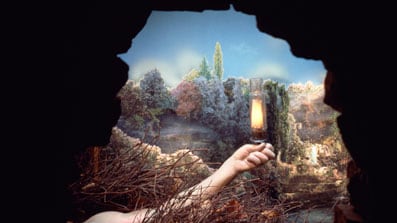Tucked away in a dark nook of the Philadelphia Museum of Art’s modern and contemporary wing lies one of the most confounding works of art of all time. It is perverse, bizarre, funny, poignant, sad, scary, revealing, literal, and symbolic all at once. And as one might expect, photographs have never done it justice.
Click Image to View Our Gallery

Marcel Duchamp’s Étant donnés is radically different from the 20th-century provocateur’s previous work (urinal-as-sculpture, a bicycle wheel fastened to the top of a stool, Nude Descending a Staircase). The piece begins with a wooden barn door pierced with two inconspicuous peepholes. For the uninformed or uncurious, that’s where it ends (it’s not hard to imagine the inner dialogue: “It’s just a door? How ‘Duchampian’”).
Peer through the holes, however, and you’re immediately captivated by the sculptural tableau beyond—a naked woman seen from the neck down, lying on a bed of twigs with a campy pastoral scene and waterfall visible in the background. The figure’s skin is pale but life-like; her legs are splayed, and her bare labia are front and center. There is something that seems victim-like about the figure, her body limp and exposed. However, the woman’s left hand suggests something else entirely. It is active, steadily holding up a gas lamp and illuminating the scene.
Working in secret for 20 years, Duchamp constructed much of Étant donnés in his diminutive studio on West 14th Street in New York, confiding only in three women (two lovers, one wife, to be exact) and, in the work’s later stages, artist/collector William Nelson Copley. By the 1940s, Duchamp had gone “underground” with his art, claiming to have given it up entirely for chess. “Nobody had any interest in what he was doing because nobody, including myself, knew he was doing anything,” Copley once said. “This gave him all the freedom in the world.”
Duchamp decided in the 1950s to will his pièce de résistance to the Philadelphia Museum of Art to join the largest collection of the artist’s work. Étant donnés was permanently installed at the museum in 1969, one year after Duchamp’s death. It has since beguiled artists, critics, and art historians alike with its uncharacteristic look and perceivably lewd message. Jasper Johns called it “the strangest work of art any museum has ever had in it”; visitors feigned shock, bemoaning the piece to the director and even, at times, to guards and staffers in the galleries; and in his New York Times review, John Canaday wrote: “For the first time, this cleverest of 20th-century masters looks a bit retardataire.” It became sort of an art world in-joke and there’s little existing scholarship on the piece. It seemed, for the longest time, that no one quite got it.
The Philadelphia Museum of Art hopes to change that with Marcel Duchamp: Étant donnés, a new exhibition on view through November 29th. The show gathers a fascinating array of photographs, documents, objects, and artworks related to Étant donnés and its conception. It also pays tribute to the museum’s late director Anne d’Harnoncourt, who helped with the original installation of the piece as a curatorial assistant.
“The show was 10 years in the making,” curator Michael R. Taylor explains, “and required lots of detective work.” Taylor and d’Harnoncourt tracked down 100 items, working closely with Duchamp’s heirs. An opening gallery reveals an early study and a series of Polaroids taken by the artist in an effort to document the piece as he relocated his studio to East 11th Street in 1965. The sizable space leading to the work itself permanently houses Duchamp’s similarly enigmatic “Large Glass,” or The Bride Stripped Bare By Her Bachelors, Even. Displayed around it are erotic trinkets in vitrines—objects Duchamp sent to friends (Johns, for one) and family as gifts. The photos, original plaster casts, Surrealist magazines, and studies that fill the walls and two more display cases reveal the artist’s process and visual stimuli (waterfalls photographed while vacationing in Bellevue, Switzerland; painter Paul Delvaux’s handling of the female form).
It’s a comprehensive retrospective, but many of the show’s conceptual underpinnings lay in a series of objects that aren’t on view: Duchamp’s letters the Brazilian sculptor Maria Martins, the artist’s lover for most of the 1940s, which Taylor admits, delayed the show for years. Never before published, the letters remained out of reach to Taylor and d’Harnoncourt until they were sold at auction in 2006 (reproductions of them appear in the exhibition catalogue).
And it is Duchamp’s letters that contain the exhibition’s big reveal: the love story. Three of them, actually, for it seems that the figure in Étant donnés is, in fact, an amalgamation of the three women Duchamp loved in the last 20 years of his life. First there’s Martins who, as his tortured writing suggests, was Duchamp’s great love (and lust—in one letter he presciently calls her “my woman with the open pussy”). The figure is cast from her body and he consulted her on each and every detail during the piece’s conception. There is also Mary Reynolds, the Parisian bookbinder who is alluded to in the parchment used to create the figure’s skin. And finally, there is Alexina “Teeny” Matisse. She and Duchamp married in 1951 and she remained his rock for the remainder of his life. Wisps of brown hair were originally visible grazing the figure’s neck but after taking up with the blond Teeny, Miss Étant donnés was made over with similarly pale tresses.
“One of things we tried to do from the beginning is provide context as to why it’s always seen as being about sex and violence—a 1960s context,” Taylor says. “I argue that the piece is really from the 1940s. It’s a disconnect that’s important to spell out. In 1949 people would have associated it more readily with Surrealism, artists like Hans Bellmer and Delvaux.”
The work’s unveiling in the late ‘60s also affected its reception by Duchamp’s friends and colleagues, Taylor notes. Artists like Johns, Robert Rauschenberg, and Richard Hamilton saw themselves as sons of Duchamp. “They saw the fact that they weren’t told about the piece as a big betrayal,” Taylor says. “How could they be so close to him and he never took them to the studio to see the piece? They didn’t have the freedom to enjoy that work. They came to it with a certain baggage. They couldn’t understand the hyperrealism—it seemed too Pop to them.”
It’s a younger generation of artists that’s better equipped to understand Étant donnés and deal with it in their work, Taylor argues. Canadian-born, Brooklyn-based artist Marcel Dzama, for one, handled Étant donnés brilliantly in his blockbuster exhibition at David Zwirner gallery in New York in the spring of 2008. Dzama expands upon the famed tableau in the show’s title work, Even the Ghost of the Past. Dzama creates a similar setup (door, peephole, recessed space, pastoral backdrop, etc.) but he shifts the perspective to the left. In Dzama’s take, the nude woman isn’t alone. She is lovingly clutching the hand of a nude man as the two sleep; a taxidermic fox stands behind them. The scene is suddenly post-coital.
“It started with me making sketches of the actual work,” Dzama says. “From there I began changing the situation around just slightly. It felt a bit naughty when I added another person. Like I was solving the mystery or interpreting what could be happening. I got really excited by the prospect of satisfying my curiosity.”
Dzama had read about Duchamp’s ill-fated affair with Martins. “The theory is that the work was based on how his ‘lady of desire’ was out of his reach,” Dzama adds. “He could only be a voyeur in her life and never physically be a part of it again. Maybe my piece allows them to be together in the end.”
The new revelations in this show suggest that Dzama may have been right.
Plus: Check out Art Beast, for galleries, interviews with artists, and photos from the hottest parties.
Rachel Wolff is a New York-based writer and editor who has covered art for New York, ARTnews, and Manhattan.






